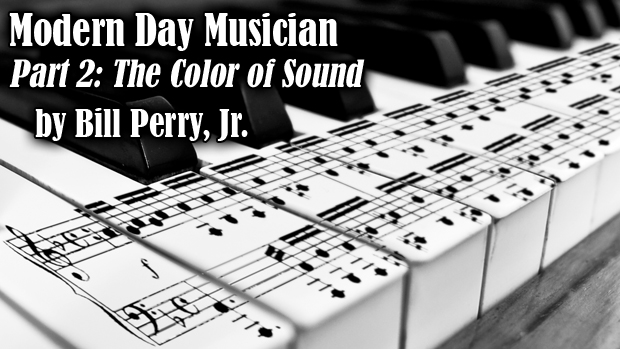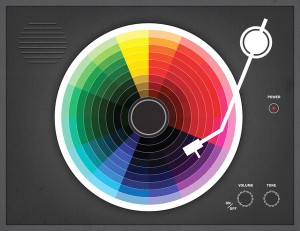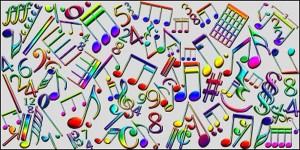
 There are many interpretations on the color of sound. There is the color of its “essence”, the color of so-called “ethnic” sounds; a “black” sound, a “white” sound etc, and the color of tones and expressions, such as “aggressive” music and “soft” music. Before I begin exploring these various theories, understand that these are my opinions and are not meant to incite or provoke anyone or any particular group. This is only meant to be discussed, debated, and hopefully taken seriously.
There are many interpretations on the color of sound. There is the color of its “essence”, the color of so-called “ethnic” sounds; a “black” sound, a “white” sound etc, and the color of tones and expressions, such as “aggressive” music and “soft” music. Before I begin exploring these various theories, understand that these are my opinions and are not meant to incite or provoke anyone or any particular group. This is only meant to be discussed, debated, and hopefully taken seriously.
Let me begin with the color of sound in its pure form, but allow me to point out some other details as a way of “connecting the dots”. It is now known that we as humans have the technology to see our aura under infrared light, and the moods we are in during various moments in our lives can be seen under this light.
For example, if we are in a somber mood, our aura may radiate a blue-ish color, if we’re under stress, angry, or highly upset, we may emit a red or yellow color because of the intensity those moods bring. We’ve all heard the phrase “green with envy” when someone acts jealous; I think we as humans are inherently in tune with the fact that colors are apart of our spirit and our universe. Look at rainbows; you can see them in the sky, in oil slicks, in prisms, in water, and so on.
Now that I’ve explained those points about “the colors within us and in nature”, I would like to make the connection it has with music. Since musicians use sound as “the paint brush” to express their music, the color of sound becomes manipulated and utilized through various mediums of expression. Just like our auras, the essence of our music lies within the colors we choose to express with.
There is no “definitive” color of sound, for that would limit the possibility of where sound and music can go, as it would be to limit a visual artist to only one color and one style. This would be a violation of what sound truly is, a divine entity that is transparent and multi-faceted in its purest form. Just like in the canvas art world, you have those who like to utilize certain colors and themes in the music world that creates a bond with those who have similar patterns, tastes and styles.
But we as musicians, dealing in audio and “mental visions”, it is harder for us to know the color of our art and its sound, until it is unleashed from within us and we can begin to paint a picture in our minds; I equate this to trying to remember a dream you had that you forgot the next morning, only to see it in fragments or not at all when you awake. To conclude my point on this matter, music in my opinion is all the colors we can see, and the colors we can’t see. It encompasses all the mysteries and enigmas of darkness and all the intensity and illumination of brightness.
 Now dealing with the widely discussed and debated “ethnic” sound topic, it is true that every culture and continent in the world have certain sounds in their music that somewhat defines their environment. But this fact has become more cliché than it has become a topic of importance, and it also creates stereotypes. Most people in the world may define the “American sound” with Jazz, Blues, Rock, Country, and in recent times, Hip Hop. But any U.S. citizen will tell you that there is a lot more to our “sound” than these particular styles, especially when it comes to fusing these styles with each other (i.e. hip-hop and jazz, rock and blues, etc).
Now dealing with the widely discussed and debated “ethnic” sound topic, it is true that every culture and continent in the world have certain sounds in their music that somewhat defines their environment. But this fact has become more cliché than it has become a topic of importance, and it also creates stereotypes. Most people in the world may define the “American sound” with Jazz, Blues, Rock, Country, and in recent times, Hip Hop. But any U.S. citizen will tell you that there is a lot more to our “sound” than these particular styles, especially when it comes to fusing these styles with each other (i.e. hip-hop and jazz, rock and blues, etc).
What issues are more debated in the U.S. are the origins of our music and its roots. One thing that can be agreed upon is almost all musical styles in the U.S. were created in the southern United States. That’s right! Big surprise to a lot of you reading this, I assume. But let’s review the facts in quick detail; Jazz was created in the south (New Orleans), Blues was created in the south (Mississippi, Louisiana, etc), Rock and Roll was created in the south (Ike Turner’s “Rockin 88” and Elvis Presley’s “That’s All Right”, and both artists were from the south; Clarksdale and Tupelo, Ms. respectively).
The only popular modern styles that exist in the U.S. today that were not created in the south are Hip-Hop (Bronx, New York), and Techno and/or “electronica” music (the Midwest states like Illinois, Michigan, Indiana, and even the eastern areas like Washington, D.C., New York, Pennsylvania, as well as influences from Great Britain).
I do not profess to know every style that exists in our country; there are many unknown styles “brewing” inside many artists everywhere in the nation, and in the world for that matter. I’m only making references to the more popular styles in the world of music today; the U.S. in particular.
And the “ethnic” sound every racial musical group is supposing to “possess” or “adhere to” is somewhat bogus. I will say this, there IS a certain “vibe” that goes along with understanding the experience music presents and where it comes from. You don’t have to necessarily be an African-
American or come from the streets of Brooklyn or the “boogie-down” Bronx to understand Hip-Hop. But you do have to understand the context of the music and where it’s coming from, and that comes from respecting and making a connection with the art and its roots, and neither your ethnic background nor color have anything to do with making that connection; making a connection with that sound and its colors are what’s really important and divine. That’s to be said about ALL musical styles!
If you’re from the streets of Memphis, Tennessee, artists like Triple-6 Mafia or Project Pat may be telling your story, or if you’re a college dropout, an artist like Kanye West may be telling your story. If you’re from Nashville, Country music may speak to you more than the average person. But country music doesn’t “define” every musician coming from that area, nor should it define them.
Nor does it define the musical tastes of every person living in that area, or any other area for that matter. You may hear some say if you do Hip-Hop and/or urban music you have a “black sound”, or if you play guitar-rock you have a “white sound”. Personally, I find these stereotypes hilarious because a person cannot be defined by what music they perform or listen to, based on what style of music they choose to express themselves with. I know and work with many white musicians who love Hip-Hop music more than any other style, and I know and work with many black musicians who prefer modern Rock and even Classical European music over Rap, Soul, R&B, and other forms of popular “black music”.
In a lot of traditional Asian music, you hear the use of sharp tones and the pentatonic scale, a 5-note system used in minor chord scales, and the diatonic scale in different tones is played as melodies over major chord structures, which is similar to Eurpoean and Western music. You can hear these scales being utilized a lot in Blues, Rock and Jazz in the U.S., but the voicing and phrasings placed on the notes are what differentiate these styles from one another…utilizing “different colors” if you will. The most important thing to remember with modern music when dealing with musical stereotypes is that there is no style that hasn’t expanded its horizons beyond the constraints of musical ethnic profiling, and the only thing music asks of you is to be true to yourself and your art.
 My final analysis on the color of sound revolves around the color of tones. I will somewhat touch on this topic explaining my theory on color tones in various music styles. In Jazz music, the musicians in this medium seem to try to reach for those 7th and 9th chords, even 11th and 13th chords, and playing notes and melodies “outside of the scale”, meaning notes that seem to ride right on the “edge” of the music; purposely playing notes outside the chord and melody of a song, making it sound “off key”, eventually returning to the root of the theme after exploring through multiple possibilities in expressing the song (i.e. McCoy Tyner’s piano solo in the Jazz classic “Resolution” composed by John Coltrane… when listening to Tyner’s solo, notice how he sometimes plays “outside the main chord structure” and utilizes scales that seem to reach in another direction; Coltrane does this as well throughout the song).
My final analysis on the color of sound revolves around the color of tones. I will somewhat touch on this topic explaining my theory on color tones in various music styles. In Jazz music, the musicians in this medium seem to try to reach for those 7th and 9th chords, even 11th and 13th chords, and playing notes and melodies “outside of the scale”, meaning notes that seem to ride right on the “edge” of the music; purposely playing notes outside the chord and melody of a song, making it sound “off key”, eventually returning to the root of the theme after exploring through multiple possibilities in expressing the song (i.e. McCoy Tyner’s piano solo in the Jazz classic “Resolution” composed by John Coltrane… when listening to Tyner’s solo, notice how he sometimes plays “outside the main chord structure” and utilizes scales that seem to reach in another direction; Coltrane does this as well throughout the song).
The color tones in Jazz can go from blue to yellow within a few bars, blue being a laid-back mood and yellow representing an enthusiastic and eclectic mood; contrasting extremes, depending on how “experimental” the musicians are.
Rock musicians tend to reach for more “aggressive” color tones in their sound, demanding immediate attention when it’s in full bloom; producing multiple images of red, yellow, and orange (isn’t it ironic that these also seem to be the colors of the “psychedelic rock” movement of the sixties?).
But Rock can also bring about grey and blue “visions” within ballads and contemplative songs. There’s a term in music called blue-notes, which simply means notes and/or tones that are utilized to create a more melancholy or somber mood, as well as expressing a bluesy and “grittier” sound if utilized in the right fashion (i.e. Cannonball Adderly’s solo in Miles Davis’ classic “All Blues”… his impeccable use of blue-notes can be heard throughout his solo). These blue notes can also be used to express a “soulful vibe” as well as sadness and contemplation.
They can also be used to bring out the “funk” in a song; I refer to these notes as “those notes that make your face frown with joy”! Like the funky bass lines in a James Brown song, those notes can make “your face frown” with pleasure!
Some may argue and say “funky notes” and “blue notes” are two different things. Once again, it’s the way you phrase your notes, melodies, and chords that bring about a multitude of expressions from certain tones; these notes are related in terms of the mood it brings out of the music.
When Ludwig van Beethoven used the A minor scale to compose the first few bars of “For Eloise”, he utilized parts of the blue-note voicing to bring out the romanticism of his notes; bringing to light the romantic and contemplative mood he was in when he wrote this composition. You can also hear the “longing” he has for the mysterious Eloise in this haunting piece of music… I see a lot of grey in this song. I feel the same way when I hear Al Green’s ballad piece “Simply Beautiful” and John Lennon’s classic “Imagine”. The colors of sky-blue, burgundy, and red-violet also float around these songs in my mind.
In a lot of Latin music, the many shades of red seem to define the “essence” of that sound, once again in my opinion. But as in all music, Latin music comes in many color tones. When I listen to “Toledo Bagel” by Paulinho DaCosta or “Jeta” by Jorge Pardo, “earth tones” like green and brown come to mind; my “third eye” begins to paint a picture and plays it out for me like a movie, where a multitude of colors, sounds, and images emerge from my conscience and my soul… all Praise is due to the Creator of the Universe!
In conclusion, the color of sound is what your mind makes it out to be. Songs that you may see darkness in; others see light in those same songs. And don’t fall into the trap of thinking a particular ethnic group listens to and/or performs a certain type of music, or that they can only “understand” a certain type of music; like saying a black person doesn’t like Country or Classical music, or that a white person can’t understand Jazz or Hip-Hop music. This will only limit your understanding on how to “paint a picture” of the world around you through music.
All the color tones in the universe are at your fingertips through music if you allow yourself to be open to the many shades of sound. Remember, the first thing echoed in the universe was sound, the Big Bang; The Divine Whole-Note! I consider myself a mere, insignificant disciple of sound in the universe who tries to harness its beauty and essence through introspection, observation, and experimentation.
With this tremendous “whole-note” created by the Big Bang, came all the beautiful colors and sounds in our known reality. I will discuss my theory on this matter in further detail in Part III: “Sound and the Universe”. The real question is what is the purpose of those who choose to use the colors of sound to express themselves? I guess the answer to that is too infinite and divine to ponder!
I bid you adieu fellow artists.
–
This article was originally printed in The Local Voice #15, published November 9, 2006.
–


